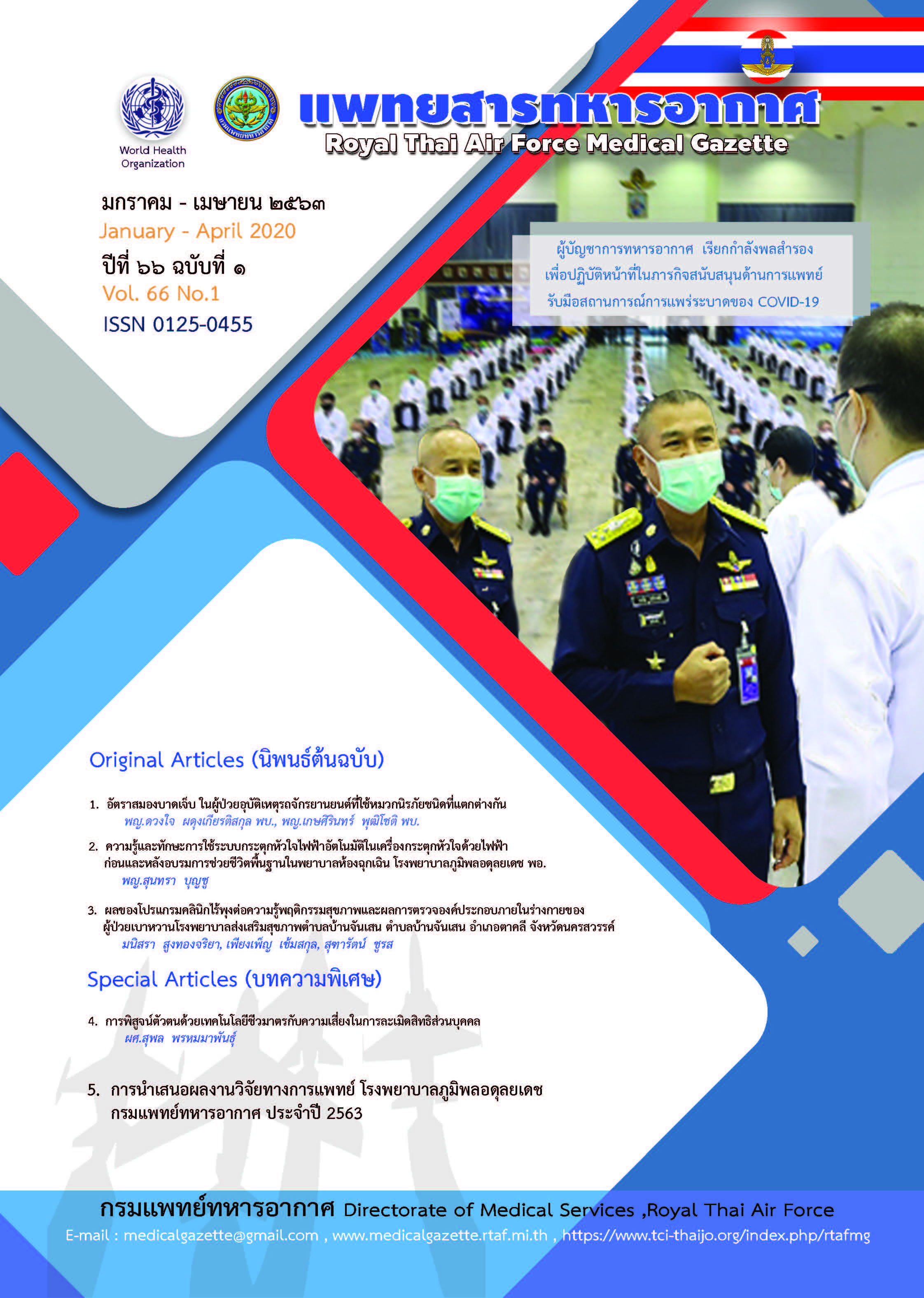The Results Of Diet and Physical Activity Clinic Program For Knowledge, Health Behavior Improvement And Body Composition Test Results Among Diabetes Patients and Hypertension Patients in Sub-district Health Promoting Chansen Hospital, Nakonsawan Province
Main Article Content
Abstract
This research is an experimental research (quasi-experimental research). The objective to study the effects of diet and physical activity clinic program and knowledge access to health behaviors and the body composition of patients with diabetes and hypertension. Subjects were patients with diabetes
and high blood pressure, uncontrolled blood glucose, or high blood pressure. Area in Sub-district Health Promoting Chansen 30 samples join the program 6 times. By selecting a specific sample (Purposive Sampling) using conventional research group measured before and after treatment. The instruments include the study. Assessment of Knowledge and Behavior Clinical applications without belly A summary and analysis of body composition. Analysis by frequency, percentage, mean, standard deviation, Paired-sample t-test. The results showed that After entering the program without clinical heart and educating. The sample had an average score of knowledge significantly increased level of 0.001. Percentage of behavioral change in a positive increase 0.001 significantly level, and evaluated body composition different from that before the trial was 0.001 statistically significant level.
Article Details
บทความที่ได้รับการตีพิมพฺเป็นลิขสิทธิ์ของวารสาร
References
quality. Nonthaburi: The Agricultural Coopera-
tive Federation of Thailand. 2015. (in Thai).
2. Stratton, I. M., Adler, A. L., Neil, H. A.,
Matthews, D. R., Manley, S. E., Cull, C.A.,
Holman, R. Association of glycaemia with
macrovascular and microvascular complications
of type 2 diabetes (UKPDS 35): Prospective
observational study. Retrieved from http://
www.bmj.com/content/321/7258/405.2000.
3. Department of Disease Control. Behavior
modification in the clinic manual NCD quality. Nonthaburi: Community Cooperatives of
Thailand. 2015. (in Thai).
4. Siwanuwatn, N. Manual diet & physical
activity clinic (DPAC). Nonthaburi: Media
Center Glass Chapel. 2015. (in Thai).
5. Intrarwichian S. Changing health behavior by
participate to sustainable in the diabetes
mellitus risk group, Kasetwisai district, Roi-et
province. Journal of disease prevention and
control 6.2012;19(2):65-75. (in Thai).
6. ทัศน์วรรณ พลอุทัย, พรรณี บัญชรหัตถกิจ. ผลของ
โปรแกรมการปรับเปลี่ยนพฤติกรรมการดูแลตนเองใน
ผู้สูงอายุที่ป่วยเป็นโรคเบาหวานชนิดที่ 2 เพื่อควบคุม
ระดับน้ำตาลในเลือด: กรณีศึกษาในตำบลห้วยเกิ้ง
อำเภอกุมภวาปี จังหวัดอุดรธานี. วารสารศรีนครินทร์
เวชสาร 2556;28(4):421-30.
7. สุทธิดา ไตรมาส, อารยา ประเสริฐชัย และวรางคณา
จันทร์คง. ผลการใช้การจัดการคลินิกไร้พุงเพื่อปรับ
เปลี่ยนพฤติกรรมสุขภาพในผู้ป่วยเบาหวานใน
โรงพยาบาลส่งเสริมสุขภาพตำบลร่มโพธิ์ อำเภอเมือง
จังหวัดสมุทรปราการ. วารสารวิชาการมหาวิทยาลัย
อีสเทิร์นเอเชีย วิทยาศาสตร์และเทคโนโลยี 2561;
12(2):210-24.
8. ชุติมา สร้อยนาค* จริยาวัตร คมพยัคฆ์ พรศิริ พันธสี.
การศึกษาแบบแผนความเชื่อด้านสุขภาพ และความเสี่ยง
การเกิดโรคเบาหวานชนิดที่ 2 ของมุสลิมวัยทำงาน.
วารสารพยาบาลทหารบก 2561;19(Supplement):
267-77.
9. Intrarwichian S. Changing health behavior by
participate to sustainable in the diabetes
mellitus risk group, Kasetwisai district, Roi-et
province. Journal of disease prevention and
control 6.2012;19(2):65-75. (in Thai).
10. Sikaew C. Public health predict Thai people
suffer with diabetes mellitus almost 5 million in
the next 8 years. Thairath. 14 Nov 2012;12.
(inThai).
11. Hmadsa S. Effects of self-management program
on glycemic control behaviors and A1C in
Muslim women with type 2 diabetes. Bangkok:
Rangsit university; 2010. (in Thai).
12. Sahaphan A. Factors predicting diabetes
prevention behaviors among those at risk for
diabetes mellitus. Bangkok: Mahidol university.
2013. (in Thai).

